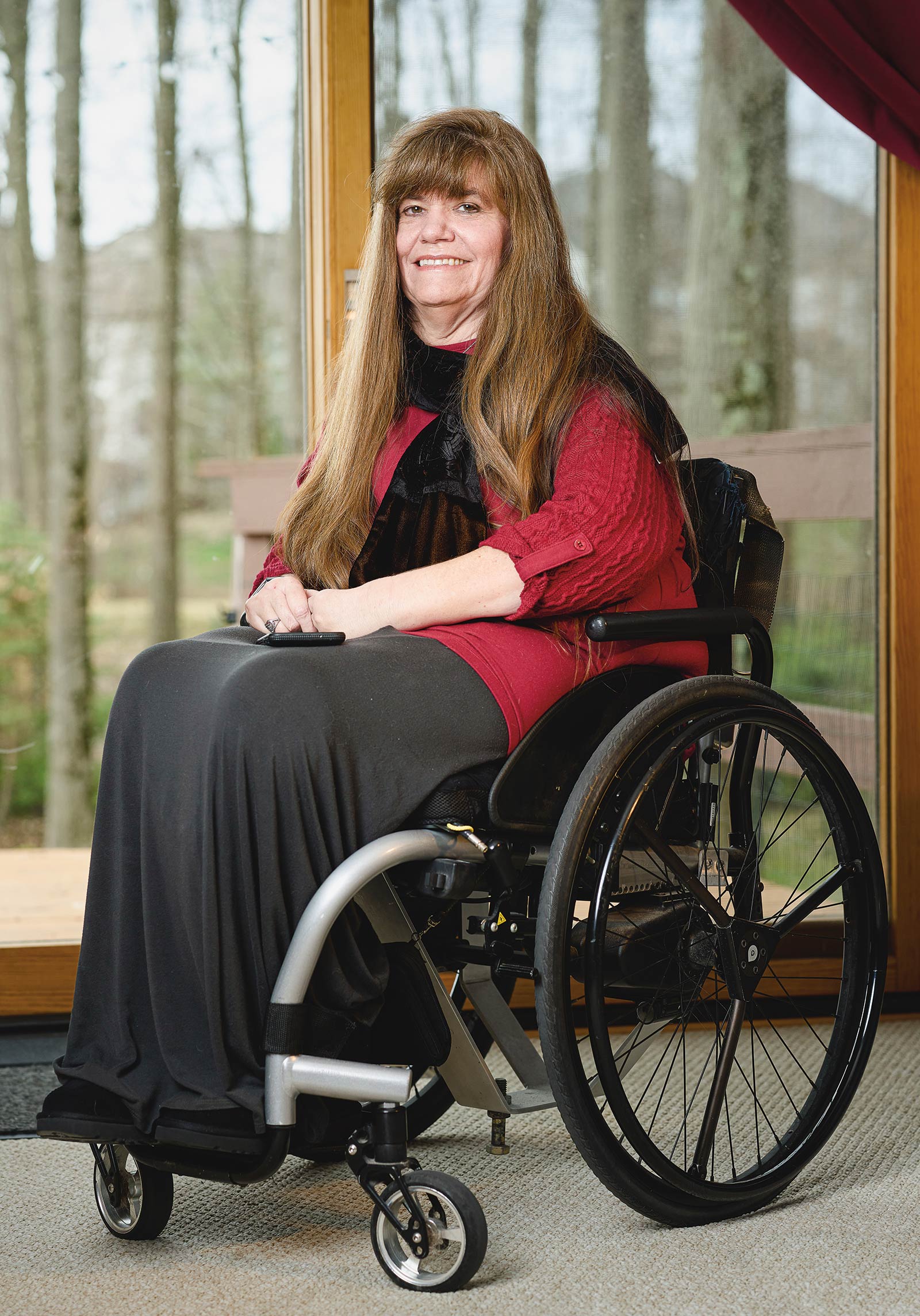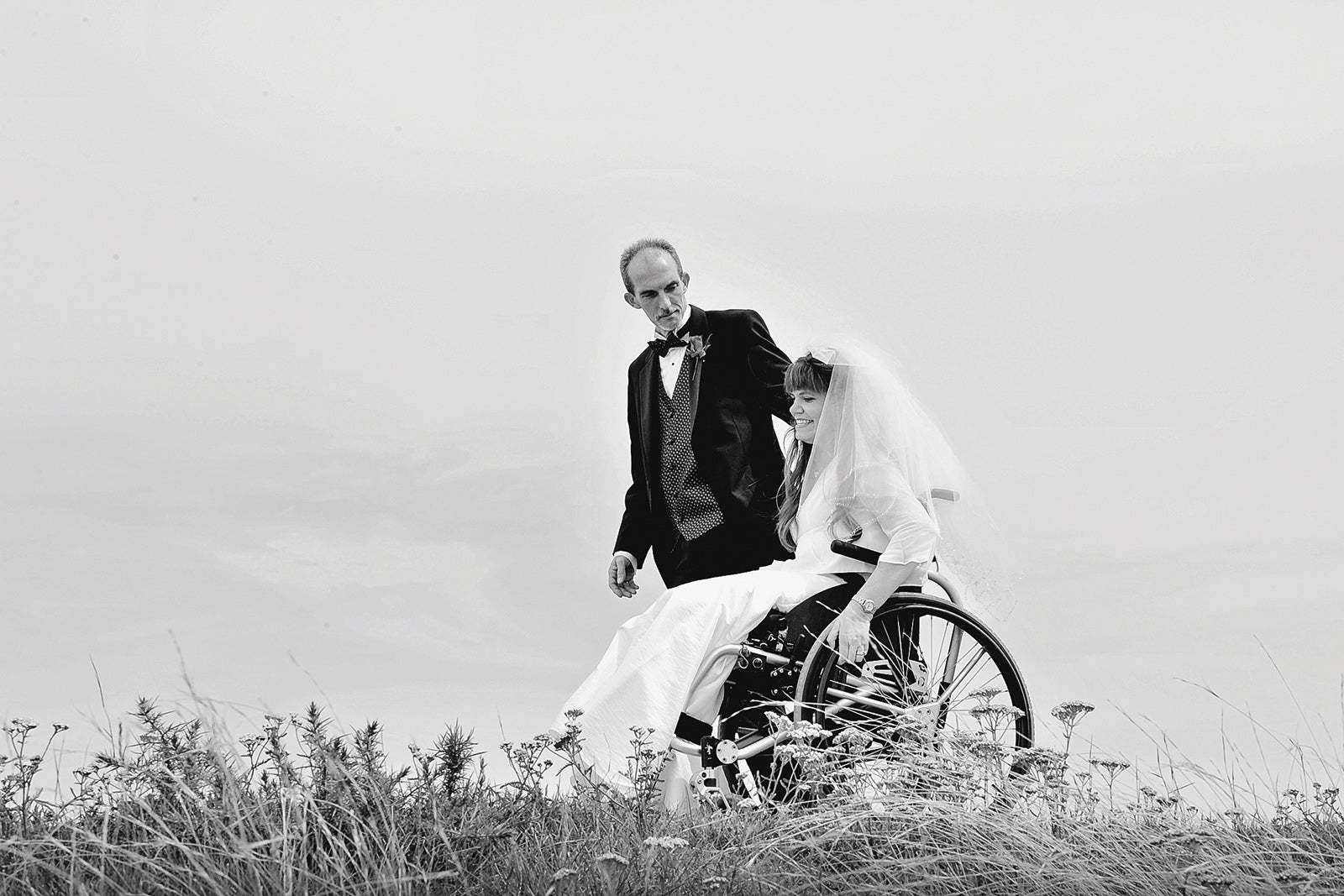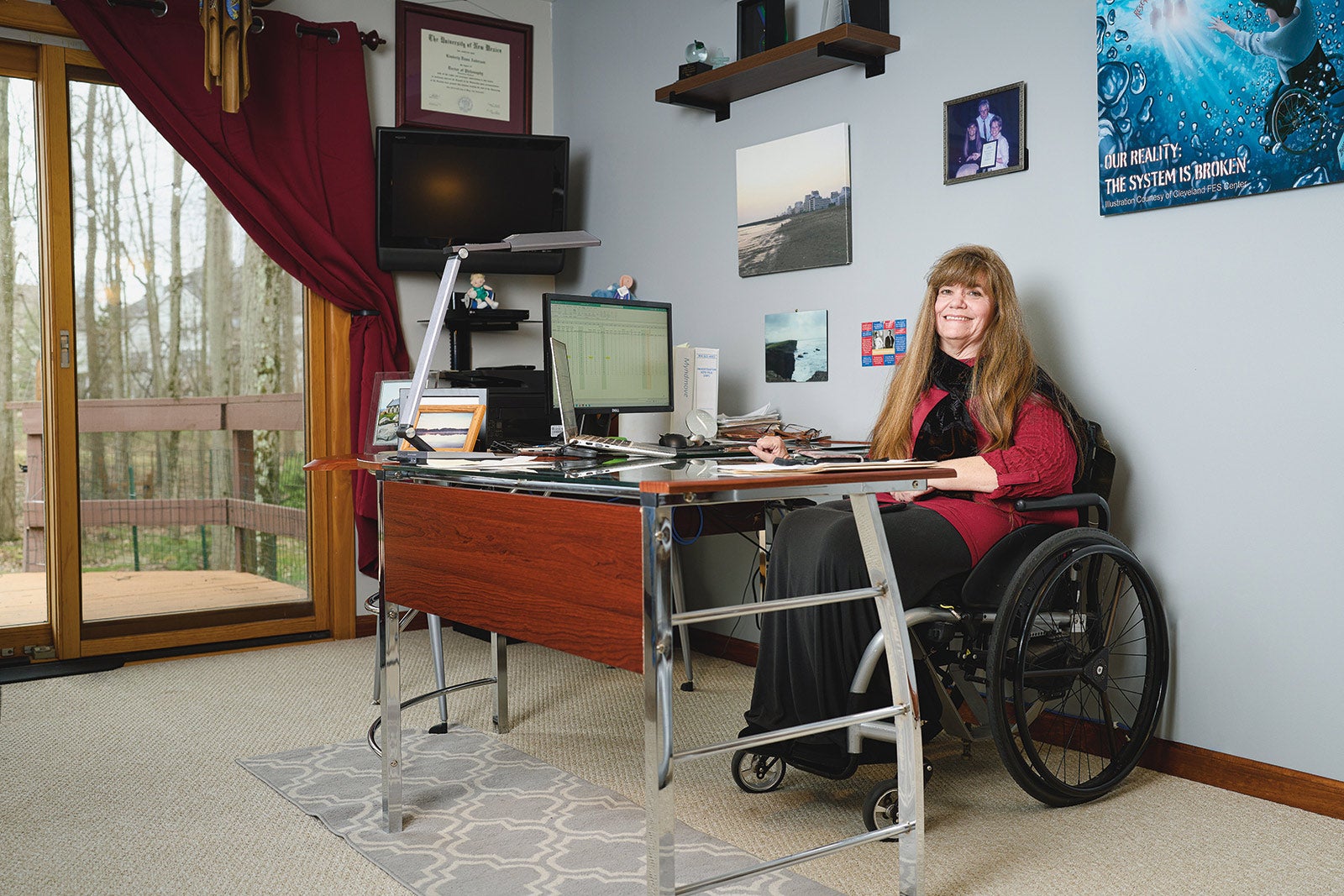features
Redefining Research
Neuroscientist Kim Anderson’s quest to amplify the voices of people with spinal cord injuries
 Photo: Roger Mastroianni
Photo: Roger MastroianniKim Anderson
Kim Anderson was vexed—caught between two communities that urgently needed to intersect.
It was the summer of 2003, and researchers at the nation’s spinal cord injury labs, including the one where she was a postdoctoral fellow, were overwhelmingly focused on finding treatments to help people with paralysis walk again.
But Anderson wasn’t only a neuroscientist—she was a woman living with a spinal cord injury herself. And the people she knew were talking about wanting to have better sex and the challenges of going to the bathroom and improving hand dexterity.
One day, when she suggested that colleagues expand their research beyond walking, they dismissed the idea because there was no data to support the shift. At that moment, Anderson knew it was time to act.
“I was like ‘OK, I’ll give you the data,’ ” she said. “‘I’m going to go survey people with spinal cord injuries, and I’ll get the proof that these issues are more important than walking.’ ”
And she did.
Anderson’s groundbreaking 2004 study, “Targeting Recovery,” served as a wake-up call for the scientific community. And it helped drive a new era in research that addressed the everyday challenges ranked highest by nearly 700 respondents, including bowel, bladder and upper-extremity function, as well as sexual health. It’s one of the most cited papers in clinical spinal injury research and has made its author famous within the field for calling out a disconnect that no one else had seen.
Last year, nearly two decades after she began the work that is steadily bridging the gap between spinal cord injury research and the community it seeks to serve, Anderson received the Craig H. Neilsen Foundation’s $1 million Visionary Prize, given to those whose bold pursuit of new ideas improves the lives of people with injuries.
Anderson, PhD, is now a professor in the Department of Physical Medicine and Rehabilitation at Case Western Reserve University School of Medicine and a staff scientist at MetroHealth Medical Center. And she continues to channel the perspectives of community members, prodding her field to rethink everything from the design of studies and barriers of clinical trials to the challenges of translating lab triumphs into tangible treatments.
As director of the Northeast Ohio Regional Spinal Cord Injury System based at the Metro-Health Rehabilitation Institute, Anderson launched an innovative new partnership with community members, seeking ways to employ people with spinal cord injuries on related research projects across the hospital. She’s also created a dedicated community advisory board to provide input on grant proposals and treatment priorities.
Anderson’s role in redirecting research priorities has been monumental, according to Jen French, president of the North American Spinal Cord Injury Consortium, an advocacy group Anderson helped found.
“Her motivation for what she does is not ‘What award am I going to get?’ or ‘Is my paper going to get cited?’” French said. “Her motivation to bring science forward—to bring the voice of the community forward—is completely based on passion.”
The determination that has defined Anderson’s career was sparked by the enthusiastic response to her first survey.
“I started to realize that my spinal cord injury was an asset as opposed to a limitation,” she said. “I was in a pretty unique situation compared to other scientists. I realized I could actually do good with that, that I could make a better impact.”
Forging a New Path
Before the car accident that paralyzed her at 17, Kim Anderson was a biology-loving clarinetist and captain of her high school marching band’s flag corps. She was also a Texan with a gentle rebellious streak who’d joined, then quit, the National Honor Society because she didn’t appreciate being told what to do.
After the accident, Anderson was the same person—only now she had to figure out how to manage life around a spinal cord injury. During her rehabilitation, one recreational therapist’s steady support became central to her recovery. Once, when Anderson refused to participate in an art session, the therapist wrapped a paintbrush around her hand with an elastic bandage and told her to just try.
“So, I did,” Anderson said. “It was messy, but it got better.”
Painting became one of her most productive therapies, increasing her arm and shoulder movement. But the lesson she’d learned was even more valuable.
“’You can still do anything you want to, you just have to figure out a different way to do it,’ ” she said. “That became my guiding force.”
Anderson left home in Austin to study at Texas A&M University at Galveston, where she met other people with disabilities, fell hard for neuroscience and got her driver’s license so she could cruise around like any other student—though it wasn’t always easy.
Once, on her way to meet friends downtown during Mardi Gras, she asked a police officer directing traffic where she could park with enough access to transfer out of her van. He waved her off.
“He told me I didn’t belong there and to go home,” she said.
Anderson did not go home. She parked, found her friends and had a festive night.
“Instead of letting it shut me down, I used it as fuel for the fire to keep me going forward and prove all those people wrong,” she said.
She resolved early on not to settle for less than the life she wanted, whether that meant ignoring a cop or stubbornly chasing her own fairytale happy ending across the world.
In 2009, when she and her fiancé, Tim Erisman, decided to get married on the South Island of New Zealand, a local woman helping plan the trip couldn’t find accessible vans. Would a minivan and portable ramp do?
It would. On the day of the ceremony, Erisman wheeled her up the ramp into the minivan and Anderson—wearing her gown and surrounded by luggage to hold her wheelchair in place—made the bumpy journey to a tiny stone church beside a glacial lake for the wedding of her dreams.
 Courtesy of Kim Anderson
Courtesy of Kim AndersonIn 2009, Kim Anderson and her fiancé, Tim Erisman, traveled to the South Island of New Zealand for their wedding.
Empowering Others
When Anderson’s survey was published in 2004, her phone began to ring—and ring. She was invited to write papers and attend conferences across the country. The momentum inspired her to plot an unusual career path to bridge the gap between the scientists and community.
“I was going to know basic science,” she said. “I was going to know clinical science. And I was going to know the community.”
As a junior faculty member at the University of California, Irvine, she spent the next decade building skills in each of her target areas. She bolstered her research chops studying digestive changes after spinal cord injuries and immersed herself in complicated federal regulations needed to run clinical trials. When an opportunity to lead community outreach as director of education for a spinal cord injury research program at the University of Miami opened up, Anderson and Erisman packed their van and headed east.
Her clinical research remained centered on community perspectives. She designed studies to understand chronic pain, barriers to exercise and sexual function to help researchers direct their work toward more effective therapies.
“It was always refocusing the point of why we are doing this,” she said. “Asking the question, ‘How is that going to make any difference to a person with spinal cord injury?’ ”
But while Anderson’s work had helped transform the scope of spinal cord injury research, another critical step remained unfulfilled: Breakthrough discoveries in labs were not reaching the community, as communication gaps between people with injuries and researchers persisted and clinical trials failed to enroll enough participants.
At a 2015 conference, listening to scientists express their frustrations about such difficulties, Anderson had another “aha” moment. The expertise of people living with injuries was the “missing piece of the wheel.” She had begun her career amplifying the perspectives of those with injuries, but it wasn’t enough: People with injuries needed to be considered research partners, not just patients.
 Photo: Roger Mastroianni
Photo: Roger MastroianniWhen Kim Anderson first sought to show researchers that people with spinal cord injuries had priorities more important than walking, she surveyed players at a wheelchair football game, peppering them with questions about their daily lives. That work became part of a groundbreaking study she published in 2004 that served as a wake-up call to the scientific community.
By 2018, she joined other advocates to found The North American Spinal Cord Injury Consortium. Composed of spinal injury organizations across the United States, Canada and the Caribbean, it quickly began to drive new conversations about the need for collaborative partnerships within the field.
As Anderson worked to empower community members to have more of a voice in the research process, she brainstormed new ways to make a difference professionally. In 2017, she’d been a research participant going through a clinical trial in Cleveland that used electrical currents to stimulate muscles. It was led by rehabilitation engineering pioneer Hunter Peckham, PhD, founder of the Institute for Functional Restoration (IFR) at Case Western Reserve, now a Distinguished University Professor Emeritus and co-director of the MetroHealth Center for Rehabilitation Research.
—Hunter Peckham, founder of the Institute for Functional Restoration at Case Western Reserve, now a Distinguished University Professor Emeritus, and co-director of the MetroHealth Center for Rehabilitation Research.
Peckham’s drive to get the technology out to users resonated with Anderson; with his encouragement, she accepted a job working at MetroHealth and the university in 2018.
Anderson’s impact in Cleveland has already been wide-ranging, Peckham said, and includes: mentoring younger colleagues and helping run trials at the IFR; seeding research at MetroHealth with input from people living with injuries; and securing a prestigious $2.3 million renewal grant last year for the center at MetroHealth that she directs. The grant from the National Institute on Disability, Independent Living, and Rehabilitation Research is for centers that are considered national leaders and federally designated as model systems for their comprehensive care and research.
One of her current studies, funded by the U.S. Department of Defense, tracks how veterans and civilians define success, setbacks and recovery in their first year after injury. Another investigates whether electrical stimulation is more beneficial than physical therapy in helping people regain the use of their arms.
Her determination to seek better outcomes for people with injuries has already changed the field.
“Kim had a big impact on opening people’s eyes,” Peckham said. “Her first paper was just the start. She kept peeling layers off the onion. Now she’s trying to make sure people with spinal cord injuries really understand what their role can be and how to ask questions and how to be a colleague on these research teams and therefore how to really make an impact.”
Since the car accident that changed her life, Anderson has fought for her voice to be heard, whether at a Mardi Gras celebration in Galveston or within the labs where she forged her career. Last fall, on the afternoon she learned she’d received the Neilsen Foundation’s Visionary Prize, a lifetime of such triumphs and struggles washed over her.
“I didn’t get much work done that day,” she laughed.
But soon enough, she was back to it, a neuroscientist and a woman living with spinal cord injury on a mission.
“I do feel optimistic,” she said. “I do really feel like there is a change in the air.”





